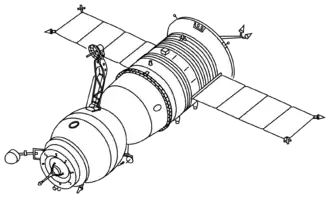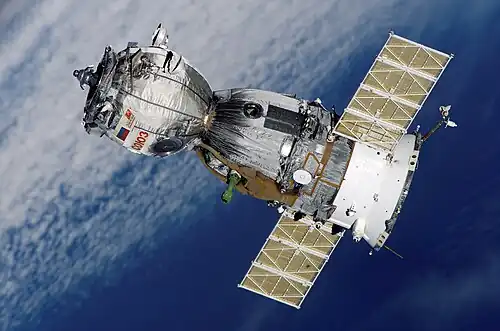Kosmos 1001
 Soyuz T | |
| Mission type | Orbital test flight |
|---|---|
| Operator | Soviet space program |
| COSPAR ID | 1978-036A |
| SATCAT no. | 10783 |
| Mission duration | 10 days, 21 hours and 2 minutes |
| Spacecraft properties | |
| Spacecraft | Soyuz-T s/n 4L |
| Spacecraft type | Soyuz 7K-ST (11F732)[1] |
| Manufacturer | NPO Energia |
| Launch mass | 6,680 kg (14,730 lb) |
| Start of mission | |
| Launch date | 4 April 1978, 15:00 GMT[2] |
| Rocket | Soyuz-U |
| Launch site | Baikonur 1/5 |
| End of mission | |
| Disposal | Deorbited |
| Landing date | 15 April 1978, 12:02 GMT |
| Orbital parameters | |
| Reference system | Geocentric[2] |
| Perigee altitude | 199 km (124 mi) |
| Apogee altitude | 228 km (142 mi) |
| Inclination | 51.6° |
| Period | 88.7 min |
Kosmos 1001 (Russian: Космос 1001 meaning Cosmos 1001) was a redesigned Soviet Soyuz T spacecraft that was flown on an unmanned test in 1978. The spacecraft was the upgraded Soyuz for Salyut 6 and Salyut 7. This Kosmos flight, launched from Baikonur, was the first orbital flight of the Soyuz T design. Several maneuvers were tested,[3] however it failed to achieve all of its objectives and resulted in an early deorbit and landing[2]
Mission parameters
- Spacecraft: Soyuz 7K-ST[1]
- Mass: 6680 kg.
- Crew: None.
- Launched: April 4, 1978.
- Landed: April 15, 1978.
References
